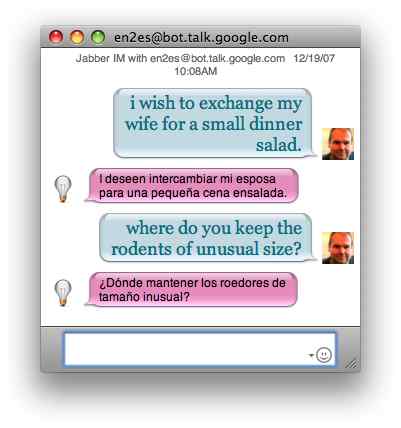Road packets.
Thursday, January 17th, 2008
I write this from the right seat of our car as we head down US 23 towards central Ohio, Columbus, the city of my birth. Had a great time last night with Nancy, Alan, and Kate in GPW, and my mission to Canada later in the morning went as well as any sojourn to Canada does these days…I swear, even some of the Canadian customs people are severe and grumpy in these paranoid times.
Nancy captures a telling moment about the postmodern nature of our getting together around a table laden with laptops and phones and cameras. We’re there, able to capture content at the drop of a bon mot, which is almost too much capability. See something you want to preserve, no matter how fleeting? 3 seconds later, you’ve grabbed and saved…and you hope you attach enough metadata to find it later in the rapidly-filling-up terabyte hard drive hanging off of your machine. At its best, having mucho life captured gives you the capability of illustrating your anecdotes almost parenthetically…holding up the iPhone as you say “and then we left Spriggy outside,” and there the dog is, captured in digital amber, just as he was, shivering.
See something you want to preserve, no matter how fleeting? 3 seconds later, you’ve grabbed and saved…and you hope you attach enough metadata to find it later in the rapidly-filling-up terabyte hard drive hanging off of your machine. At its best, having mucho life captured gives you the capability of illustrating your anecdotes almost parenthetically…holding up the iPhone as you say “and then we left Spriggy outside,” and there the dog is, captured in digital amber, just as he was, shivering.
A small handful of pre-MacWorld speculators hoped that the new MacBook Air would feature the same ubiquitous networking as the iPhone…no matter where you go, if you’re within faint wifi range or a cell tower, you’re online. But no, as network-y a machine the MacBook Manila Envelope is, it, like the iTouch, still only has wifi. Sad, because that ‘packets anywhere’ concept, especially on a long road trip, is a compelling proposition. Time and time again now we (if nothing else) reassure ourselves and alleviate stress by knowing to a Google Maps certainty that the Hampton Inn we seek is precisely where we think it is…and we can call them to reassure ourselves even further by poking that doohickey there.
Aahhhh. Peace of mind through packet presence.
Me, I’m dubious.
Monday, January 7th, 2008

I’m starting to get a lot more Google search results that are, well, a lot like this one—attempts to appear relevant, only we know they’re just faux-sites laden with bottom-feeding ads. I’ve been showing some older folks (yes! Older than me! Hard to believe!) lately how to use their computers, which these days has to include some intensive search engine instruction…and it’s hard to explain to a person who thinks that the whole machine on their desk is ‘some kinda magic’ that a link like this really represents subhuman scum trying to subvert the true ways of the internet.
The ‘you are looking at this’ reminds me of a classic story from my college TV station. I’ll be brief. In the days of live booth announcers, we had versions of our legal ID (“You’re watching WOUB-TV Athens and WOUC-TV Cambridge”, or simply “You’re watching public television.”) in varying lengths, from fifteen seconds down to three. You chose the right one to fill the time. What happens when the duty director calls for a two-second ID? The young woman in the booth intoned, “You’re watching television.”
Indeed!
Continuing my theme of being awash in nostalgia for the old days of television, I came across this wonderful collection of scanned-in photos, meticulously annotated, of television stations and facilities in Atlanta, Columbus, GA, New York, and elsewhere. Wow…the gear, the clothes. There’s even a photo of an actual Vidifont I have sweated over in a noisy tape room on West Peachtree Street. So, I was inspired to clean up my Vidifont brochure pictures a bit. Mmmm…Vidifont, is there nothing it can’t do?
Happy Iowa day.
Thursday, January 3rd, 2008
It’s the day of the Iowa caucuses, and as a designer who has been there (“on the scene! Live! With boots on the ground!”) to design two television stations over the years (I’ve been annoying Sammy with “that’s my eight! that’s my three! Those are my county outlines!” as we see an Iowa newscast or two on C-SPAN) I can verify the one tangible piece of reporting emerging from the Hawkeye state.
It’s damn cold there.
Heck, it was damn cold there last April, when I made a midnight run to pick up a denim jacket from a 24-hour Wal-Mart in Mason City just to keep from shivering in meetings.
Beyond that, it’s anyone’s guess how the actual caucusosity will play out (at this moment), but folks seem to think there is a real role for retail politicking (as opposed to the tarmac-politicking that Tim Crouse delineated in 1972 and reporters have been re-characterizing since then.) But as New Hampshire proves, you can have small-scale retail politicking and then go and, like, y’know actually vote, like most of us do in the primaries.
One of my favorite Crouse-like moments of this campaign thus far, accurately capturing the cold, fatigue, and caffeine-craving is chronicled here at the CJR.
Why can’t we get together and come up with a system that assures we, the voters, of much more of a retail experience, where we might actually be able to go somewhere and hear he or she speak, no matter where we are?
It’s not like there hasn’t been a truckload of reports on how poorly this primary structure is gonna serve us this year. And Iowa just serves as this odd, frozen offbeat way to get the mania started.
Christopher Hitchens tells us that the caucuses are a sham, the Times says that they empower just a few people in a state that has just a few mostly white people, but most of the network news promos breathlessly say “the first votes are cast!” Well, yeah, if by ‘cast’ you mean people standing around in one corner…then another…then they’re lured over by the living room fireplace by warmth and cookies.
Brr. We went for a walk today to the park and it was substantially less windy and cold than yesterday, but I still got an Iowa flashback or two. Here! In Atlanta!
Bright resolutions.
Wednesday, January 2nd, 2008
“Well, you just know it’s gotta be a better year than 2007.”
That’s the compiled fervent wish of the websites of people I either for-real know and therefore visit or think I know and therefore visit. If wishes were a renewable energy source, we’d be all set, because I can feel the collective semiconscious out there wishin’ and hopin’ for a bright sunny day with every ‘page down’ I press.
I share that optimism—although a quick review of last year’s early posts will show you that I generally evince a slight default optimism—even in the face of the sad events that started last year, so, well, another data point toward the theory that blog posts don’t mean much of anything.
I think we have a chance in the next 45 days or so to set a political course for our fellow US citizens that will lead us to brighter times, although I’d say this year’s slate of republicans and democrats has a much higher goofball ratio than any I can remember…and I can remember Barry Goldwater. That’s gotta be a good thing. I’m going to be studying the weather mapping databases to see if the added hot air masses over Iowa and New Hampshire disrupt the jet stream.
New Years 2008 did transition for us from foggy dampness to bright, clear and cold, which is a practical improvement, if not a portent. We’ve done all the right year-end-transitioning things—I tweaked the CSS on Sammy’s site, made note of the end-of-year mileage. We went over to my brother’s house for a New Year’s Day dinner packed with those good luck foods that southerners revere (although most of the diners were transplanted midwesterners.) Black-eyed peas, greens, mashed potatoes. Dark-chocolate-coated Edamame. You know, the traditions.
On the way back, I realized we now have a car that alerts us—while driving—when the temperature drops below 37ºF, but isn’t smart enough to realize that if the roads are bone-dry, there’s nothing too threatening about those conditions.
So in many ways, Sammy and I are set for 08. Our bills are paid. We have lots of friends we care about and (often) get a chance to visit. We have the stuff that some covet—a cool car, a cool phone, lots of cool computers, ipods and a cool HD set. Our house is warm (enough) and we’re saving water from our dishes and showers.
The decks are thus cleared for positive consequences. Well, let’s see, eh?
Portapak world, encore une fois.
Sunday, December 23rd, 2007
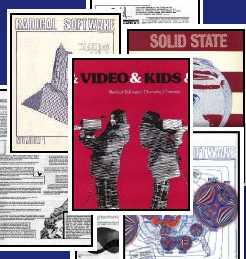 Wow, here I was thinking about early alternative video last week or so and now, a few of the surviving pioneers of early handheld television…the heroes of helical, the visionaries of vidicon tubes, have gone and put the preeminent journal of that technology in that time, Radical Software, up on the web in a near-flawless example of preservation, giving us searchable, downloadable riches. The wise communiards of the Videofreex and the Raindance folks, live again, in earnest black-and-white pixels…this time in PDF, not NTSC.
Wow, here I was thinking about early alternative video last week or so and now, a few of the surviving pioneers of early handheld television…the heroes of helical, the visionaries of vidicon tubes, have gone and put the preeminent journal of that technology in that time, Radical Software, up on the web in a near-flawless example of preservation, giving us searchable, downloadable riches. The wise communiards of the Videofreex and the Raindance folks, live again, in earnest black-and-white pixels…this time in PDF, not NTSC.
This publication (and no, ‘Software’ did not refer to computer programs in that far-distant context) was one of my textbooks, one of my guides during my Goddard days, and paging through the Letraset-ty, IBM Composer-typeset and typewriter-type pasteups seems to not only nurture my nostalgia centers, but get me to thinking more about Big Ideas in the realm of communications perched here comfortably into the 2000s.
The portable videotape camera-and-tape deck system, or “portapak,” has been called by some, the most revolutionary breakthrough in media since Gutenberg.
—Philip Lopate in “Aesthetics of the Portapak,” in volume 2 number 6. And he was just getting warmed up. I wonder how many times Gutenberg’s name has been invoked in the context of new communications technology, say, since Gutenberg?
There are some real surprises here, and I’m gonna have to plow systematically through here to glean all the cool stuff. (If you’re interested in the basic history, this page does a fine job of pulling that together.) Did you know that Seattle glass artist Dale Chihuly was an early force in independent video as he tried to use the new medium to broaden and illuminate the older one? Mhm. Looking at pages packed with experiments-in-video-as-public-art (“walk through a room full of monitors showing scenes from around the world, and…”) …well, I wonder what they’d make of The Situation Room.
Wolf Blitzer ≠ Nam June Paik, in my estimation.
Boy, if the early Whole Earth Catalogs and Mother Earth Newses would be given this quality of online preservation (nicely-scanned PDFs with searchable, cut-and-pasteable texts), I would be in seventies heaven, and maybe some Ideas Worth Sharing would be given new lives.
Reading in bed.
Friday, December 21st, 2007
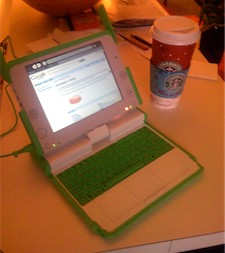 I’ve written about (without laying hands on) Amazon’s Kindle and of course I’ve been exploring with our new OLPC (One Laptop Per Child) XO, poking and prodding it through external connections, reconfiguring it so that it chats with the outside world correctly, calling up page after web page (“hmm, that looks quite readable and fine.”), but I didn’t draw any dots connecting the two. This O’Reilly Radar post does…it considers the OLPC as a reading machine (which, indeed, it is.) Purchasing the XO represents the same cash outlay (although the Get One, Give One program provides two machines—you keep one—for that price)…its screen is larger than the Kindle’s (had no idea), the OLPC has terrific wifi reception versus the Kindle’s ‘free’ EVDO cellular networking…and of course the XO will display web pages, feeds, PDFs, ebooks, pretty much everything you throw at it…and that’s where the Kindle steps aside.
I’ve written about (without laying hands on) Amazon’s Kindle and of course I’ve been exploring with our new OLPC (One Laptop Per Child) XO, poking and prodding it through external connections, reconfiguring it so that it chats with the outside world correctly, calling up page after web page (“hmm, that looks quite readable and fine.”), but I didn’t draw any dots connecting the two. This O’Reilly Radar post does…it considers the OLPC as a reading machine (which, indeed, it is.) Purchasing the XO represents the same cash outlay (although the Get One, Give One program provides two machines—you keep one—for that price)…its screen is larger than the Kindle’s (had no idea), the OLPC has terrific wifi reception versus the Kindle’s ‘free’ EVDO cellular networking…and of course the XO will display web pages, feeds, PDFs, ebooks, pretty much everything you throw at it…and that’s where the Kindle steps aside.
Oh, and the XO’s screen has color (except in bright outdoor light) and more dots per inch.
And is all open source.
At any rate, I stayed up late reading last night on the XO, depleting its batteries for several hours. I’m worried that the clicking of the ‘page down’ key might be just a bit too loud for extensive in-bed reading next to a sleeping partner, but it worked well otherwise.
BotTalk, babelfish-style.
Wednesday, December 19th, 2007
Hand me the universal translator, Mr. Spock. Google launched almost-instantaneous translations in your chat client today, and the Mandarin one is already clogged up. But hey, my Spanish is improving!
XOXO to children everywhere.
Tuesday, December 18th, 2007
 There are buses that go from downtown Oaxaca out to Xoxocatlán, which is, I guess you’d say, a suburb of the capital city of Oaxaca state, perched on the south side of the huge hill the archaeological site Monte Alban sits on. It’s pronounced “hoho-caht-LAN”…and folks know the bus is going there because a simple ‘XOXO’ has been scribbled high up on the windshield. A bus with hugs and kisses.
There are buses that go from downtown Oaxaca out to Xoxocatlán, which is, I guess you’d say, a suburb of the capital city of Oaxaca state, perched on the south side of the huge hill the archaeological site Monte Alban sits on. It’s pronounced “hoho-caht-LAN”…and folks know the bus is going there because a simple ‘XOXO’ has been scribbled high up on the windshield. A bus with hugs and kisses.
I think of that town, for some reason, when I look at the OLPC XO that Sammy and I bought as part of their “Give one, Get one” program. It is a cute, tough machine whose logo is a merger of an X and O into a human shape (some have said the Cingular guy got work after he was laid off), and Xs and Os permeate the clever user interface.
It arrived Saturday in the rain, and the UPS person tucked it up against the front door, where we first spotted it Sunday morning (we’re glad neighborhood thieves were out partying elsewhere Saturday night.) Out of the slightly damp box came a cleverly-designed computer, the work of a devoted team of people who are trying to put these in the hands of as many of the world’s children in as functional a way for as cheap a price as they can.
As part of that mission, for a bunch of obvious political reasons, they want to make it 100% open source, resilient, and accessible. It is a minimalist machine by many folks standards—only 1 GB of Flash memory instead of a hard disk, and 256 MB of RAM, and a single-core processor. And yet, because of the hard work of a determined team that cannot be said to be in it for any reason other than to help, it is what it is, a fine machine for a child to use to work with, to learn, to paint, draw, write, communicate, and oh yeah, play. There are a lot of smarts inside and behind this machine, and plenty of Python-y juiciness to play with (what other machine lets you examine the source code of running applications with the touch of one button?)
One of the people who saw it at James and Rebecca’s holiday open house on Sunday paid it the ultimate compliment: “What kind of Mac is it?” Several said they could see using it as a small coffeehouse writing and surfing machine. (This speaks, by the way, to a general worldwide desire for a powerful, light subnotebook, that I hope will be satiated by a new kind of MacBook in January.) Many liked the idea that you could buy one while simultaneously buying one for a kid somewhere for whom the XO might open all kinds of rich doors.
I’m certainly a Mac guy, an admirer of clever design, and yet I have no trouble extending that admiration to the work of the folks who made the OLPC XO. There are some really smart choices and decisions made here (and a few dubious ones, but hey, it’s version 1.0.) Thanks for doing something.
If I had $10,000…
Wednesday, December 12th, 2007
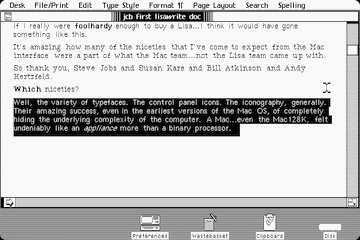 …back in 1983, I would have been just nerdy enough to buy one. And sit, broke, in my apartment, creating documents no one would ever read on the first no-kidding GUI-based computer (I exclude the Xerox Alto here), not to be confused with its successor, the Mac, which really, really changed everything.
…back in 1983, I would have been just nerdy enough to buy one. And sit, broke, in my apartment, creating documents no one would ever read on the first no-kidding GUI-based computer (I exclude the Xerox Alto here), not to be confused with its successor, the Mac, which really, really changed everything.
And made me $2500 or so poorer as it did it.
Now, thankfully, I can simply download a free Lisa emulator and party like it’s 1983. LisaWrite! LisaCalc! LisaTheWebHasn’tBeenInventedYet!
(Click on image to see it larger, by the way.)
There’s a great site that pulls together software that allows you to run dozens of old computers, calculators, games, and doodads in emulation…I am astonished, heartened, amused by the accumulated urges of long-time computer users to recreate the digital homes they left behind so many upgrades ago.
I understand that urge. It’s irrational, but I share it. A machine very much like my old IBM Selectric is on sale at eBay. I hear it’s call, I have no need. Maybe someone will write a Selectric emulator…
Portapak world.
Wednesday, December 12th, 2007
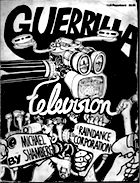 Sometimes I think I have Seasonal Nostalgic Disorder. I correlate it fairly closely with my attempts to clean our house…to remove the layers of clutter that come from the deadly combination of being alive for a good long time plus being fans of the printed word. The plus side of that is you come across stuff you think has long left for the dumpster. Like this book.
Sometimes I think I have Seasonal Nostalgic Disorder. I correlate it fairly closely with my attempts to clean our house…to remove the layers of clutter that come from the deadly combination of being alive for a good long time plus being fans of the printed word. The plus side of that is you come across stuff you think has long left for the dumpster. Like this book.
I have long been, as you know, a fan of television, and I remember getting very excited when Guerilla Television came out…this now thoroughly antique 1971 publication posited a world where television would be democratized by these newfangled “portapaks”—we’d all walk around with tiny video cameras, recording everything…and that would lead to A Better World.
Quoth Shamberg and company:
It may be that unless we redesign our television structure our own capacity to survive as a species may be diminished.
Wow. Far out, man!
The “first how-to book for new media tools” got me excited by the prospect of being able to create videos just like the big guys, but by the mid 1970s when I went off to college and actually tried to use a Portapak and looked at the results—blotchy, fuzzy black and white images that couldn’t even cleanly transition—in a cut—from one shot to another without additional hardware, more tape, a good deal of luck, and the willingness to put up with even more analog generation loss. That’s correct…you couldn’t cut…even that caused a roll and bounce of the wobbly helical videotape recording.
From my standpoint, this vision arrived well ahead of the technology, and in what may be a telling piece of self-realization, I knew that the only television I wanted to make was crisp, clean, and what was then called “broadcast quality.” I was willing to go work at “big media” (although it turned out to be a baby version of that at Ted Turner’s WTCG) to use (expensive) tools that made good-looking product…it didn’t bother me (again, tellingly) that my message was “watch Casablanca, tonight at 8 on the SuperStation.”
It took an extra decade or two for the vision of democratic television to become realized, but I think we are now living in a post-YouTube world, where it really is easy to put video “out there.” Yeah, maybe too easy.
But here, amidst a big-media writers’ strike, amidst consolidated big-media’s attempts to put out cheaper programming in as many monetizable (is that a word?) forms as possible, amidst endless uploads of water-skiing dogs, it a treat to be able to reread this early attempt to characterize what must have seemed like a far-off world…where everyone can do TV.
And the author? Well, he went on to become pretty big, old media—he produced The Big Chill, Pulp Fiction, and..uh..Reno 911. Wonder what he thinks about the strike? Or, about YouTube as the democratizing of television?
Bargains like these.
Tuesday, December 4th, 2007

Ah, the holiday shopping season. Amazing deals everywhere you look…but it helps if you put your brain on ‘pause.’ (from Consumerist.)
Kindle!!
Tuesday, November 20th, 2007

Okay, let me first explain the joke…when my brother and I were working latenights at an Atlanta TV station on design stuff, along about three am they’d rerun episodes of The Fugitive, and over several cycles, we became very familiar with Barry Morse’s oft-spoken line of dialog, bellowed in desperation as David Janssen excaped him yet again.
“Kimble!!”
And now, on to the Amazon.com-created reading device that is all the talk since its introduction yesterday. My take on it is short and sweet: I’m glad they’re experimenting, trying things out, but the DRM protection and the restrictions on use/sale/trade fly in the face of everything that Jeff Bezos has historically said about the nature of books (stuff said when he was trying to rationalize Amazon’s selling used books.) The device itself seems a bit clunky for a reading-only tablet…you’d think that it wouldn’t need full alphanumeric keyboard if all you were doing was navigating a well-designed interface.
It kinda looks like the 1960s Star Trek reading tablets (‘PADD‘s), where I’d want something more like the 1990s-era Star Trek the Next Generation reading devices. Although the 1968 reading tablets from Stanley Kubrick’s 2001 would do nicely as well.
And I think once folks do the math (including paying for ‘selected’ RSS feeds), you’ll find out that the cost of the tablet’s EVDO-like cellular connection is no great bargain. Just like Apple with AT&T, doesn’t seem like Amazon has made much headway in breaking the broadband wireless providers’ stranglelock.
All that said, I think I’ll hold out (not that I’m really gasping in anticipation or anything) for a small tablet-computer, about the size of a large paperback book, that reads web pages and PDFs and Word documents and connects to wifi and…well, you know, like my phone, but with a bit larger screen.
Mooove it on over.
Monday, November 19th, 2007
 Ah, wait a moment and someone will cobble together the gem of an experience that had occurred to you and take it and run with it up there on the internet.
Ah, wait a moment and someone will cobble together the gem of an experience that had occurred to you and take it and run with it up there on the internet.
For some reason, on a cold grey Michigan morning a few years back, the breakfast spread at my in-laws just cracked me up: “Move over Butter”, with a pissed off cow, surely akin to the arrogant chicken that served (still serves?) as the University of Delaware mascot (who, yes, I just checked, used to look like an actual, if aggrieved, chicken..uh, in a sweatshirt, but now looks a lot more like Woody Woodpecker’s spawn.) Cartoon ad animals…they’re just more fun when they’re…upset.
And of course, the fact that it’s just one attempt out of dozens to create and market artificial stuff that is not no way no how butter…and yet, you still want those magic six letters up there. Reminds me of this current trend of frustrated advertising copywriters who boldly banner the words “legally, we cannot say…” and then go on to make the most outrageous claims in hopes that you’ll chuckle at their little lawyer evasion and get sucked in by the claim.
Hey, move over, copywriters.
Moments of picket-line zen.
Thursday, November 15th, 2007
As you may have heard, television writers are on strike. This means, among other things, that we’re deprived of topical political writing. It also means we’re deprived of witty Daily Show-like coverage of the strike itself.
But wait, not so fast:
What I get from this video: the writers deserve what they’re asking for (of course I thought that before the strike), and two or b, when you strip away the TV production hoohah, the core of what makes anything funny, interesting, great, entertaining is the writing. It’s right there.
And, of course, I love the over-the-shoulder graphics.
Leapt?
Monday, October 29th, 2007
 Over the weekend, dozens, nay, tens of thousands of Macs worldwide were upgraded to Mac OS X Leopard, the latest version of an operating system that has been refined in five major releases since its introduction early in this century. Have I, yet? Well, actually, I first installed (a beta of) Leopard back in June (see photo at right…our little MacBook at WWDC)…marveled in its features, delighted in its potential, and then reverted that puppy back to 10.4 as soon as I could so that it would..uh..work.
Over the weekend, dozens, nay, tens of thousands of Macs worldwide were upgraded to Mac OS X Leopard, the latest version of an operating system that has been refined in five major releases since its introduction early in this century. Have I, yet? Well, actually, I first installed (a beta of) Leopard back in June (see photo at right…our little MacBook at WWDC)…marveled in its features, delighted in its potential, and then reverted that puppy back to 10.4 as soon as I could so that it would..uh..work.
And since the official release, we’ve been waiting for our ‘up to date’ copy that comes with Sammy’s new machine (a lovely large-screen iMac, purchased last week.) So have we leapt, at this moment? No. But soon, very soon.
Since my beta taste, the hard working folks in Cupertino have been working hard, and we can add this new milepost on their amazing parade of major releases:
- Mac OS X 10.5 Leopard 10/26/2007
- Mac OS X 10.4 Tiger 04/29/2005
- Mac OS X 10.3 Panther 10/24/2003
- Mac OS X 10.2 Jaguar 08/23/2002
- Mac OS X 10.1 (internally, ‘Puma’) 09/25/2001
- Mac OS X 10.0 (internally, ‘Cheetah’) 03/24/2001
By comparison, Microsoft Windows XP was released in October 2001, and its successor in major releases, Windows Vista, came out in January of this year.
Apple has a challenge in marketing this latest version of their OS: do you tell the truth and talk about the staggering number of underlying improvements and innovations that are, for the most part, beneath the surface? Or do you play up a couple of whiz-bang, comprehensible features that the average joe will want? (The promotion of Time Machine gives you your answer.)
The reality is: you should buy Leopard for the underlying work, because it lays the foundation for huge amounts of whiz-banginess in almost every aspect of the apps you use in the future. I would also add that the shipping product..10.5.0, is really in some ways just a way to get in the door…I predict the refinements and bug fixes and tweaks in the next six months will be 1) essential and 2) a big part of getting your money’s worth.
The Apple developers, when not distracted by things like iPhones and Apple TVs, have been working hard to add powerful new core functionality. And with a hard end-of-October deadline, they’ve pushed hard and delivered a product that is both astonishing and probably a little bit rough around the edges. But for many of us, the improvements will be worth those edges:
Take Core Animation, a framework for making interface stuff move with fluid elegance with very very little effort on the part of an application developer will eventually make everything in the land of Mac have that elegant dynamism you see now on the iPhone. And then there’s the capability to create and run 64-bit programs, which is a boon for the scientific and technical computing world…and also makes it possible to use all of your microprocessors’ power in ways that take pages to explain. They’ve added filesystems and frameworks that make backup and working with the metadata contained in the zillions of files on your hard drive much easier.
But any of that added functionality only comes with an upgrade to Leopard. Yep, you’re gonna start to see a lot of “Mac OS X 10.5 only” labels on downloads.
Ironically, the two application suites that were once at the fingertips of many, many mac users—Microsoft Office (Word, Excel, and so on) and Adobe (Photoshop, Illustrator, inDesign) are now the programs that least take advantage of these under the hood refinements. It’s hard for them to leverage Mac OS X 10.5-specific functionality—if not impossible—because they’ve committed themselves to a single code base for multiple platforms…Windows and Mac…and because Apple hasn’t given them much of a developmental head start.
They (sometimes stubbornly) have their own way of displaying text, holding on to internal data structures, and even dropping menus—and it’s not that their ways are bad, they just don’t take advantage of what the underlying operating system and the Cocoa frameworks (libraries of reusable code that, if used, give you that head start) have to offer. There’s waste there…there can be a performance hit as well, since code to do the same thing is loaded yet again into memory where perfectly good code sits, ignored, lonely.
So what does this mean to the end user? There’s a real benefit to “buying in to Cocoa,” and using Leopard along with applications—like Apple’s own iWork apps instead of Office—that take advantage of the new underlying goodness.
I’d also call to your attention new Cocoa-wonderful apps like Gus Meuller’s Acorn—a lightweight, inexpensive, clever alternative to Photoshop, that may be part of the key towards living a zippy, Microsoft and Adobe-free life. It gets no small part of its speed and wonderfulness by “buying in” and embracing as much Cocoaosity as it can.
I think an argument can also be made if that you’re a contrarian, who lives their lives in Office instead of iWork, in Firefox instead of Safari, who doesn’t think much of iPhoto…well an upgrade of operating system isn’t going to bring you much in terms of added performance or functionality…and in fact may cause more trouble for you than its worth. Stick with Tiger for a while. It’s fast, stable, relatively lean.
But eventually the siren call of new underlying functionality will get you to upgrade…you’ll find one app you just have to have with that “Mac OS X 10.5 only” label…and there you’ll be.
The Power of the Third Party.
Wednesday, October 17th, 2007
 The real Steve Jobs said today “Let me just say it.” Okay, go ahead, Steve, say it.
The real Steve Jobs said today “Let me just say it.” Okay, go ahead, Steve, say it.
We want native third party applications on the iPhone, and we plan to have an SDK in developers’ hands in February. We are excited about creating a vibrant third party developer community around the iPhone and enabling hundreds of new applications for our users. With our revolutionary multi-touch interface, powerful hardware and advanced software architecture, we believe we have created the best mobile platform ever for developers.
This is, of course, a very different sentiment than laying out an obstructionist approach: “they break in, we lock em back out,” rinse, repeat.
Jobs (and his company) may have had this general strategy all along—let’s see how much excitement there really is; let’s see just how many people are battering at the door.
Turns out, quite a few. Estimates of the number of people who have unlocked their phones to allow 3rd party apps onboard vary, but they’re large enough to constitute interest and enthusiasm.
Apple would have been foolish to ignore the sheer energy that comes from big crowds of youthful developers who want to craft coolness into the device they pull from their pockets to impress people at coffeeshops, airports, and meetings. Those enthusiasts are out there now, breaking down the door every time that Apple re-bars it, and I’m glad that Apple has decided not to waste that creativity and word-of-mouth buzz, juice, whatever.
So next February, they open the door, under some sort of (as yet still) mysterious parameters, they stand back, and oh yes, they will reap the rewards.
It’s not that Apple doesn’t have or couldn’t hire enough developers to create the amount of software that is showing up for this “best mobile platform ever”…but if piles of apps are just handed out from Cupertino, sometimes, dare I say it, the bounty gets taken for granted. Apple actually runs the risk of this with a steady release of new revs of all that iLife and iWork stuff. “Oh, yeah, I have those programs on my machine. Not sure what they all do, but yeah, they’re on there.”
If packages emerge (with some real sparks of new ideas) from the third-party community, that software seems to arrive encapsulated in a heightened, shinier quality of buzz, juice, spark.
Often, the development has been open. We’ve read about it in the land of blogs. Other 3rd party developers have enthused. It may even be open source, which may do exactly nothing for the end user but generates a whole other level of enthusiasm online.
And finally, of course, sometimes a small but powerful idea of uncommon originality will emerge and catch fire from completely outside the Cupertino mothership…and those more fragile, more important ideas are fanned into life more successfully in the nurturing environment of the third party world.
If Apple succeeds in constructively channeling this energy, well, then get ready for all kinds of multi-touch doohickies from the land of Apple that will work much the same way as the iPhone and the iPod Touch did…but in your car, on your kids’ school desktops, and so on.

